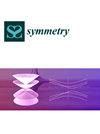Studying Alumina–Water Nanofluid Two-Phase Heat Transfer in a Novel E-Shaped Porous Cavity via Introducing New Thermal Conductivity Correlation
IF 2.2
3区 综合性期刊
Q2 MULTIDISCIPLINARY SCIENCES
引用次数: 0
Abstract
Investigating natural convection heat transfer of nanofluids in various geometries has garnered significant attention due to its potential applications across several disciplines. This study presents a numerical simulation of the natural convection heat transfer and entropy generation process in an E-shaped porous cavity filled with nanofluids, implementing Buongiorno’s simulation model. Analyzing the behavior of individual nanoparticles, or even the entire nanofluid system at the molecular level, can be extremely computationally intensive. Symmetry is a fundamental concept in science that can help reduce this computational burden considerably. In this study, nanofluids are frequently conceived of as a combination of water and Al2O3 nanoparticles at a concentration of up to 4% by volume. A unique correlation was proposed to model the effective thermal conductivity of nanofluids. The average Nusselt number, entropy production, and Rayleigh number have been illustrated to exhibit a decreasing trend when the volume concentration of nanoparticles inside the porous cavity rises; the 4% vol. water–alumina NFs yield 17.35% less average Nu number compared to the base water.引入新的导热系数关系式研究新型e型多孔腔中氧化铝-水纳米流体两相传热
由于纳米流体在多个学科领域的潜在应用,研究不同几何形状的纳米流体的自然对流传热已经引起了人们的极大关注。采用Buongiorno的模拟模型,对纳米流体填充的e型多孔腔内的自然对流换热和熵产过程进行了数值模拟。分析单个纳米颗粒的行为,甚至在分子水平上分析整个纳米流体系统,可能是非常密集的计算。对称是科学中的一个基本概念,可以帮助大大减少这种计算负担。在这项研究中,纳米流体通常被认为是水和Al2O3纳米颗粒的组合,其体积浓度高达4%。提出了一种独特的相关性来模拟纳米流体的有效导热系数。随着纳米颗粒体积浓度的升高,平均努塞尔数、熵产和瑞利数呈下降趋势;与碱性水相比,4%体积水-氧化铝NFs的平均Nu值降低了17.35%。
本文章由计算机程序翻译,如有差异,请以英文原文为准。
求助全文
约1分钟内获得全文
求助全文
来源期刊

Symmetry-Basel
MULTIDISCIPLINARY SCIENCES-
CiteScore
5.40
自引率
11.10%
发文量
2276
审稿时长
14.88 days
期刊介绍:
Symmetry (ISSN 2073-8994), an international and interdisciplinary scientific journal, publishes reviews, regular research papers and short notes. Our aim is to encourage scientists to publish their experimental and theoretical research in as much detail as possible. There is no restriction on the length of the papers. Full experimental and/or methodical details must be provided, so that results can be reproduced.
 求助内容:
求助内容: 应助结果提醒方式:
应助结果提醒方式:


